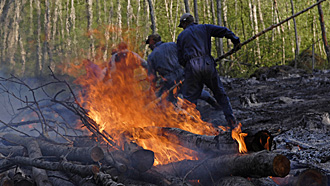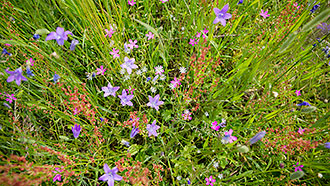Natural Features of Linnansaari National Park


Slash-and-burn culture lives on at Linnansaari Croft
This disappearing tradition is being maintained at Finland’s Linnansaari and Koli national parks. Slash-and-burn agriculture also preserves deciduous forests. Read more >

Mowing encourages an abundance of flowers
Space for demanding meadow species is cleared every year at Linnansaari croft. The sheep pastured in the park also contribute to nature management. Read more >
Saimaa’s archipelago nature is fascinating in every season
The National Park is a 40 km long and 5 - 10 km wide area in the middle of Lake Haukivesi, a part of Lake Saimaa which is the largest lake in Finland. The magnificent landscape alternates between a labyrinth of sheltered islands and broader open waters. The park includes more than 130 islands and hundreds of smaller islets and protruding rocks. The purchase of the core areas of the national park was justified with their natural beauty. Preserving Finland’s original lakeland nature for future generations and research was mentioned as the justification for the establishment of the national park.

The landscape in the national park ranges from deciduous forests to sun-soaked rocks and meadows. Vegetation on the islands is characterised by sharp contrasts: behind rugged lichen-covered rocks lining the shores you will find lush herb-rich forests.
Ospreys and water birds
Gliding over the open waters of Lake Saimaa, the Osprey (Pandion haliaetus) is a majestic sight. The Osprey is one of the biggest birds of prey in Finland, and Linnansaari has one of the densest osprey populations in the country. Ospreys nest in the staunch tops of the shoreline pines. In the large twig nests they usually have 1 - 3 young birds. The osprey is very skilful in search of prey. Shallow lakes with clear water are ideal places for them to be able to see the fish. It is amazing to watch how they dive on their prey and take off again with fish in their talons.

The osprey migrates to warm Africa for the winter. It can fly as far as to South-Africa, which makes a 12,500 km journey! Faithful to its native place, the osprey returns to the same area every year. The first brood they usually have at the age of three years. The osprey couples stay together all of their life. Read more about the osprey (saaksisaatio.fi).
The primitive cry of the Black-throated diver (Gavia arctica) together with the choir of gulls arrange the summery concert of the archipelago. The apparently abundat Lesser black-backed gull (Larus fuscus) is endangered, since the species has strongly decreased on past decades.
Groves and white-backed woodpeckers
Linnansaari has an abundance of herb-rich forests. Herb-rich forests and grove-like heaths account for as much as 30 per cent of the forested area of the National Park. Herb-rich forests comprise only one per cent of all Finnish forests.
White-backed woodpecker (Dendrocopos leucotos) thrives in the herb-rich and open forests of Linnansaari dominated by old deciduous trees. This bird species remains endangered even though its population has grown in recent years. The woodpecker and the wealth of demanding species make the herb-rich forests important in terms of nature protection.

You may spot strange flowers when hiking in Linnansaari. Bird’s nest orchid (Neottia nidus-avis) and ghost orchid (Epipogium aphyllum), two orchid species lacking chlorophyll, are two peculiarities of the herb-rich forests of Linnansaari. Sweet woodruff (Galium odoratum) has also found a suitable habitat in Linnansaari, which lies at the northern edge of its range.
Herb-rich forests and forests inhabited by white-backed woodpeckers have been actively managed in Linnansaari since the late 1980s. Removing spruces from deciduous forests creates light for herb-rich forest plants and openness for woodpeckers. In such environments, white-backed woodpeckers can safely search for larvae from decaying tree trunks lying on the ground.
Because of slash-and-burn farming and logging carried out in the 20th century, the forests in the park are relatively young. Most of the old trees in natural state can be found in forests growing on cliffs.
Chequered blue is the jewel of the insect world of Linnansaari
In the National Park, 346 Macrolepidoptera species have been found, which is almost a half of all the species found in Finland. The diversity of natural features in the inland archipelago makes an ideal environment for butterflies and moths in the lush aspen groves, bare rocks and the old meadows and clearings created by the slash-and-burn agriculture. The species include the threatened Chequered Blue (Scolitantides orion), and the rare Scarce Fritillary (Euphydryas maturna), the Baptria tibiale, the Dotted Carpet (Alcis jubatus) and the Trichosea ludifica.

These species have become rare, since cattle no more grazes in the forest keeping open the small clearings where the butterflies and moths live.
The extremely rare beetle Aulonothroscus laticollis occurs in Linnansaari
An extremely rare occurrence of Aulonothroscus laticollis was found in the Linnansaari National Park in Rantasalmi during a survey of species in herb-rich forests. This species has been sighted only once before in Finland, in 1865. The Aulonothroscus laticollis is a species of beetle included in the family Throscidae, and it is about four millimetres long. The habits of this species are not known with certainty due to its rarity, but observations suggest that it lives in tree litter forming in the cavities of hollow deciduous trees. The beetle probably feeds on fungal mycelia growing in the litter in the cavities.
The many deciduous forests of Linnansaari and aspen as an individual species offer habitats for dozens of insect species. The larvae of many butterfly species, such as Aglia tau, Catocala adultera and Mimas tiliae, only live on deciduous trees or on plants growing in herb-rich forests.
Linnansaari National Park
- Established 1956
- Area 97 km²

The Emblem of Linnansaari National Park is Saimaa Ringed Seal
Publications of Linnansaari National Park
Publications of Linnansaari National Park (julkaisut.metsa.fi).






